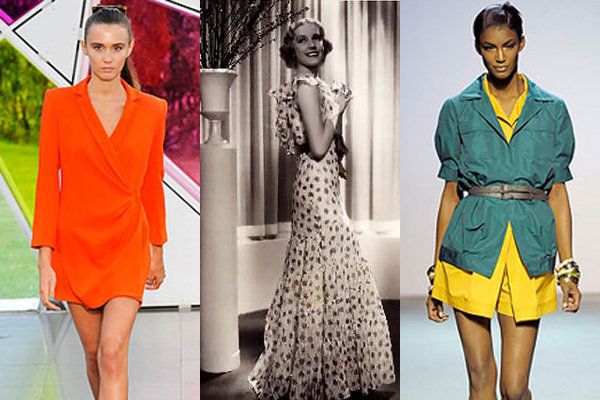
According to the fashion industry, colorful clothing is the stimulus solution to our newfound spending blues. Ranging from rich bold hues like plum, hot pink, and neon orange to more muted palettes of coral, mustard yellow, lilac and nude, designers are banking on a cheery pop of color for the coming months to tempt American shoppers into pulling out that last credit card they haven't yet shredded.
"When the economy is tough, people want something that looks optimistic," says Michael Kors. "No matter how much doom and gloom goes on, they want to believe that anything is possible."
Claudia Cividino, president of Adam, cited strong sales of colorful looks over more practical basics during the market week for wholesale fashion buyers in late September, just as the financial crisis hit.
So we know that color is coming, but will we be buying, or is the fashion industry trying to put a cheerful face on an ill-timed trend? The traditional fashion buying cycle begins one year before a season, with orders for products placed six months prior to launch, so what we see on the runway today was conceived well before the Dow plunged below 10,000. Even though the economy has been heading south for a while, the effects of its decline probably weren't a major creative influence on fashion designers and their vision of Spring 2009.
With economists predicting a two year recession and fashion companies both large and small struggling to survive the sudden dearth of available credit, it will be interesting to see how the times affect design choices-- from both a business and creative standpoint. "What we find attractive is not a stable currency," says Terry F. Pettijohn II, a psychology professor at Coastal Carolina University. Mr. Pettijohn, who has studied how economic and social factors shape cultural preferences, posits that our fluctuating beauty ideals are "affected by the environment, by what's happening in society, and what makes us feel more comfortable in threatening times."
It remains to be seen how our current events will influence fashion's outlook over the next few seasons. Will designers choose escapism or realism-- and what will the models look like who depict it? If the past informs the present we could look to the great depression of the 1930's to give us some clues. According to the book New York Fashion: The Evolution of American Style by Caroline Milbank:
-The 1930's produced clothes that even at their most elegant reflected leaner times: for the first part of the 1930's figures were almost emaciated; clothes were narrow, long and spare. In comparison with the flapper, the ideal woman of the 1930's was older, more sophisticated and much less carefree.
-Whatever the budget of the thirties woman, her dress had to go a long way. It had to wear well and its design had to stand up to being worn well: it couldn't look dated after several seasons. This explains the simplicity of the clothes... and the rise in importance of accessories. Thirties accessories became more dashing to perform a very important function: changing the look of a relatively simple suit or dress from one wearing to the next.
Perhaps the economic meltdown will permeate the fashion industry in a way that will encourage more thoughtful, well-executed, high quality design. A fresh focus on quality over quantity would surely be a welcome relief from the frenetic pace of our acquisition centric times. Albert Einstein said, "Out of the clutter, find simplicity. From discord, find harmony. In the middle of difficulty lies opportunity." I hope that from a fashion perspective, this can translate into clothes that are really worth their price tags.